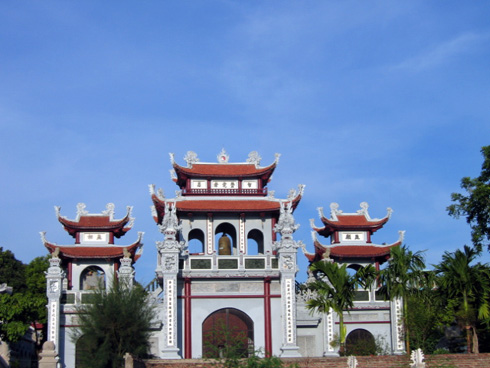
Webmaster
Bất động sản
VLXD - TTBNT
Dịch vụ Tài chính
Du lịch-Khách sạn
VLXD - TTBNT: (84-8) 38633036
Bất động sản : (84-8) 38633037
Dịch vụ Tài chính: (84-8) 38633040
Dịch vụ Ôtô: (84-8) 38622684
Du lịch-Khách sạn: (84-8) 38633041

- Giá vàng
- Tỷ giá






Hanoi Attractions(17/12/2010)
One
Pillar Pagoda

The original name of the pagoda was Dien Huu pagoda which literally means
long lasting happiness and and good luck. The pagoda is situated in the western
part of the city. It was first built in 1049 in the reign of King Ly Thai Tong.
legend has it that at time King Ly Thai Tong was very old and had no sons of
his own. One night he had a dream that he was granted a private audience with
Buddha with a male baby on his hands. Buddha seating on a lotus flower in a
square-shaped lotus pond in the western side of Thang Long Citadel, gave the
king the baby. Month later the queen got pregnant and she gave birth to a male.
To repay the gift from Buddha, the king ordered the construction of a pagoda
with was supported by only one pillar resembling a lotus seat on which Buddha
had been seated. The pagoda was dedicated to Buddha.

Temple of Literature-Quoc Tu Giam was the first
Sword
Restored
The lake which is not as large as Ho Tay to the northwest is situated in
the center of the city. Because of its unique location

Hoan Kiem lake which had been considered the most beautiful lake in the
city was in the 19th century added with another object to make it more
beautiful and famous. That was the construction of a temple on the Ngoc (Jade)
islet in the lake. Initially the temple was called Ngoc Son Pagoda. Later it
was renamed
On the long way that leads to the
temple there are several cau doi (parallel sentences) written on the wall.
These cau doi are considered part of a traditional ward puzzle entertainment, a
lifestyle literally educated persons of ancient Thang Long used to follow.
The three ancient Chinese which are still seen today on the top of the
entrance to the temple means Tran Vu Quan. That is literally the temple which
is dedicated to Saint Tran Vu. A temple is a place for worshipping saints while
a pagoda is dedicated to Buddha and faithful disciplines.
Saint Tran Vu was a legendary
figure which was a combination between a legendary character in
The Chinese legendary figure was a
saint who made great contributions in safeguarding the northern border.
Another object of no less
significant is a smaller black bronze statute of Old Trong, a chief artisan of
the bronze casting team who had made the giant statute of Saint Tran Vu and the
great bell on top of the tree-gate entrance. To commemorate the great
contributions of the teacher Old Trong, his students of bronze casting cast his
statute and placed in the temple for their for their younger generations to
remember Old Trong for ever.

The temple is also called

The Youth Road can be compared to a beautiful bridge spanning across the
two large bodies of water - West Lake to the northwest and Truc Bach
The west lake area is estimated at 480 hectares, being the biggest lake
in the city. A road that runs around the lake is as long as 12 kilometers. It
passes several flower-growing villages such as flower Nghi Tam village, Tay Ho,
and Peach tree planting Nhat Tan village. Situated nearby the lakeside road are
several famous pagodas and temples such as Phu Tay Ho and Kim Lien Pagoda. In
feudal regimes many royal palaces and rest houses have been built to used as
resort places for kings and senior court officers. Now Ho Tay has been
earmarked for the city's major tourism development center.
Ho Chi Minh's Mausoleum

After two years of construction, the mausoleum of President Ho Chi Minh
was officially inaugurated on August 29,1975. The facade of the mausoleum faces
the historic
The mausoleum is divided into
three layers with a combined height of 21.6 meters. The lowest layer forms a
terraced stand exclusively used for the presidium of grand meetings organized
at the grassy
The mausoleum is the place to keep the remains of President Ho Chi Minh,
the great patriotic who had been conferred the title "World Cultural
Activist" and the national hero. The conferment was made on the occasion
of the centenary anniversary of President Ho Chi Minh's Birthday (1890-1990).
The mausoleum project was the results of artistic labor of both
Vietnamese and former
The Ho
The museum displays relics about the life and work of President Ho Chi
Minh, a cultural figure and hero of the national liberation movement
(1890-1969). The museum was inaugurated on May 19,1990, the anniversary of the
Centenary Birthday of President Ho Chi Minh.
Address:3 Ngoc Ha St,
The

The museum is a national museum. It was founded in 1926 and named
"Ecole d'Etreme Orient." In 1958 it was restored and renamed the
Address:
The
The museum is a national museum. It was founded in January 1959, It
exhibits relics from various phases of the Vietnamese people's patriotic and
revolutionary struggle from the founding of the Vietnam Communist Party up to
the present day.
Address:
The
The museum is a national museum which was established in June 1959. War
relics and trophies reminisce great periods of the armed struggle of the
Vietnamese people. Evolutions of the two recent great historic battles: the
Address: 28A
The
This is a national museum founded in June 1966. It displays art works and
objects of the various nationalities living in
Address:

- Ho Chi Minh City - Saigon Attractions
- Traveling in Quang Ngai
- Sightseeings & Tourist Attractions in Vietnam


 Tiếng Việt
Tiếng Việt English
English Chứng khoán:
Chứng khoán: 




















